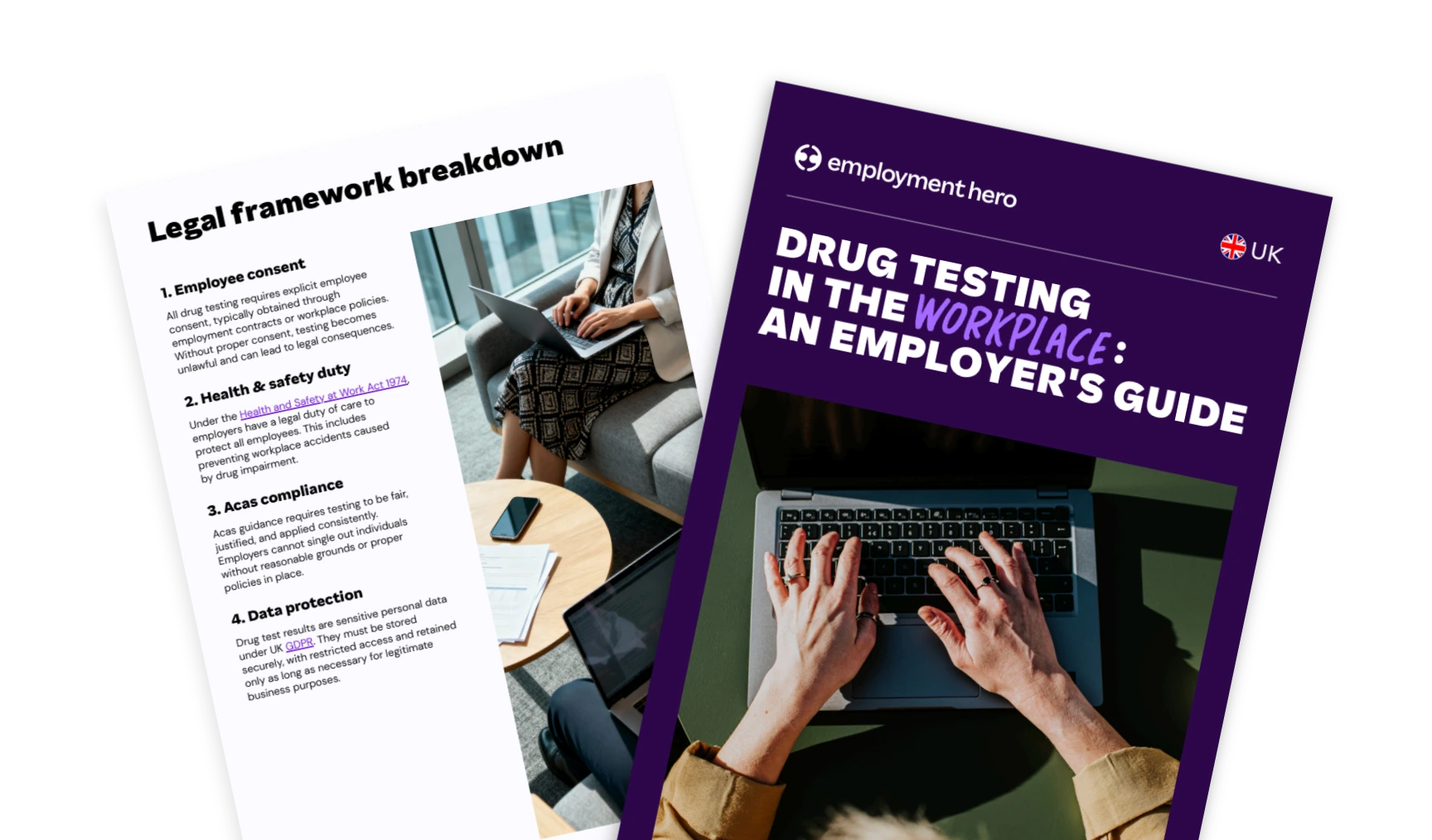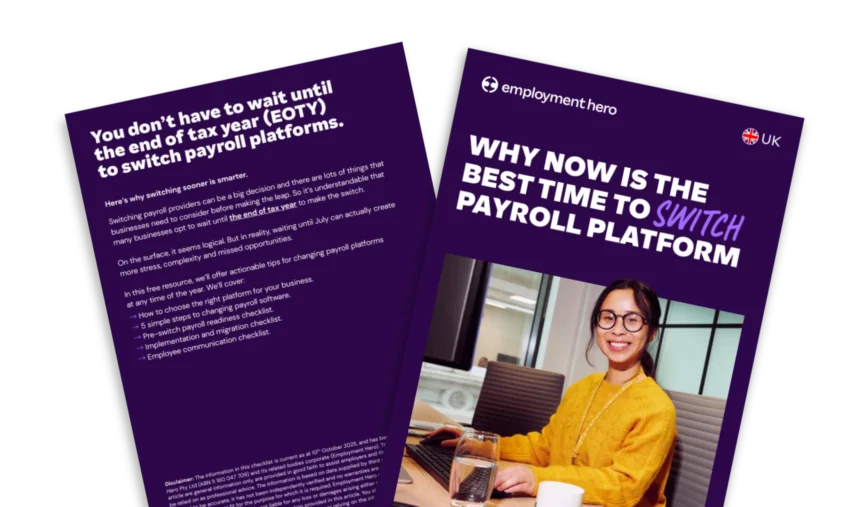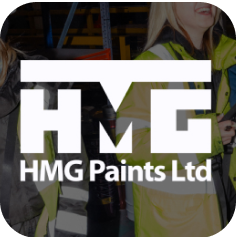Why Now Is The Right Time To Switch Payroll Platform
Published
Why Now Is The Right Time To Switch Payroll Platform
You don’t have to wait until the end of tax year (EOTY) to switch payroll platforms. Here’s why switching sooner is smarter.
Switching payroll providers can be a big decision and there are lots of things that businesses need to consider before making the leap. So it’s understandable that many businesses opt to wait until EOTY to make the switch.
On the surface, it seems logical. But in reality, waiting until April can actually create more stress, complexity and missed opportunities.
In this free resource, we’ll debunk the EOTY payroll myth and show you why making the move sooner is not only possible — it’s smarter.
This resource includes:
- How to choose the right platform for your business.
- 5 simple steps to changing payroll software.
- Pre-switch payroll readiness checklist.
- Implementation and migration checklist.
- Employee communication checklist.
Download our free resource.
The myth vs the reality
When it comes to payroll, one of the biggest misconceptions is that you should only switch providers at the start of a new tax year. But this misunderstanding can cost businesses time and money, so having all the facts is essential.
Let’s dive into the myth vs the reality.
The myth
‘Switching payroll mid-year is too complicated — it’s better to wait until EOTY for a clean start.’
This is a concern many businesses have and we get it, the EOTY does seem like a sensible time to change platforms. Many businesses assume that moving mid-year will create data gaps, reporting headaches, or compliance risks. On the surface, it feels safer to hold off.
The reality
Modern payroll systems, like Employment Hero, are designed to make transitions seamless at any time of year. All your Year-To-Date (YTD) figures, tax information and employee records can be imported directly from your existing provider. That means you won’t lose any data and your reporting will stay accurate from day one.
In fact, waiting until EOTY can sometimes make things harder. New tax rates and system changes often come into effect at the start of the tax year, adding extra complexity to your setup. By switching earlier, you can bed in your new system well before these updates roll out and give your team one less thing to worry about.
The takeaway? The ‘EOTY switch’ is an outdated idea. With the right payroll solution, the best time to switch is when your business is ready — and sooner is usually better.
The benefits of switching sooner
1. Seamless data migration
To the relief of anyone managing payroll, modern systems are more advanced and can handle more complex tasks, so a mid-year-transition is no longer a big ask. In fact, modern platforms are built to handle mid-year transitions… without losing data.
Advanced systems, like Employment Hero import all Year-To-Date (YTD) data, including earnings and tax to deductions, from current providers. Full Payment Submissions (FPS) are also used to ensure everything aligns perfectly. Historical data, such as sickness leave and average pay records, can also be transferred. In short: no matter when you switch, your payroll history comes with you.
This ensures a smooth and stress free transition.
2. Avoid the new tax year rush
It might seem sensible to wait until the new tax year to change platforms, but this is often when payroll is at its most complex. Tax rates and tables usually change at this time, making it harder to compare your old and new systems.
A mid-year switch gets your business ahead of the game and allows your team to be familiar with the new platform annual updates kick in.
3. Take advantage of quieter periods
When considering a change to platforms or processes, it’s important to set your team up for success. And part of this includes giving them time to adjust and have some breathing space. Switching outside of the end of tax year does just this.
Summer and early autumn for example, are often calmer months. Making the transition then means your team can give the process their full attention — without the pressure of looming deadlines.
4. Save time on manual updates
An outdated payroll system that isn’t meeting the needs of the business is a headache for anyone using it. If your current platform isn’t integrated, your team is probably stuck with repetitive, manual updates.
This means that waiting to upgrade to a more advanced platform is wasting your team’s time. Having an automated platform that can deal with compliance changes and streamline workflows frees your HR and payroll team up from admin-heavy tasks, so they can focus on more strategic work.
5. Unlock features and integrations sooner
Why wait to see the benefits of a more modern payroll solution? The simple fact is, the sooner you make the switch, the sooner you’ll gain access to powerful features, such as:
- Improved accuracy: Real-time syncing reduces errors and ensures payroll compliance.
- Streamlined workflows: From onboarding to payslips, everything runs in one system.
- Smarter reporting: With all your data in one place, you get a clear, complete view of your workforce.
Tips for a smooth payroll transition
Making the move to a new payroll system doesn’t have to be daunting. With the right approach, you can set your business up for success from day one. Here are some simple tips to ensure a smooth transition:
1. Start with clear goals
Before diving straight in, you should consider why you’re looking to switch payroll platforms. Is it to save time, reduce errors, or integrate HR and payroll?
Having clear objectives will help you find the right payroll system for your business, measure success and keep your team focused during implementation.
2. Choose the right time
Timing is everything. But this doesn’t mean waiting until EOTY. Instead, pick a time that makes sense for your business. Many companies find quieter months the best time to switch payroll platforms, so keep seasonality in mind. This frees up HR and payroll teams to focus on the change.
3. Gather and clean data early
Data migration is smoother when employee records YTD figures and tax details are all up to date. So make sure you have everything in order prior to swapping to a new platform, as this will help to avoid any surprises once you go live.
4. Lean on your provider’s expertise
Implementation is essential for ongoing success with a new payroll platform, but as a business you don’t need to do it all by yourself. The best payroll platform providers, like Employment Hero, don’t leave you to figure it out alone, instead they are on hand to help you out.
Payroll implementation specialists are on hand to guide businesses through each step, from data migration to team training. Support such as this allows you to feel confident moving to a new platform.
5. Test before launch
No matter how good a platform is, or how effectively implementation is run, there is always room for error. So before launch, mitigate risks by running tests.
Run a parallel payroll cycle (using both your old and new systems) to check that everything lines up. This gives you peace of mind that your new platform is calculating pay, tax and leave correctly before you fully switch over.
6. Communicate with your team
Communication is essential, especially when you want your team to get onboard with a new piece of software. So keep employees in the loop. Let them know what’s changing, when it’s happening, and how it will benefit them (like self-service access or faster reporting). Transparency builds trust and reduces confusion.
Don’t wait, make the move to better payroll today
Waiting until the new tax year to switch payroll might feel like the safe option but in reality, it often creates more complexity and missed opportunities. With modern payroll systems like Employment Hero, there’s no need to delay. You can move anytime, with seamless data migration, dedicated support and powerful features that start delivering value right away.
The sooner you switch, the sooner your team can enjoy smoother processes, stronger compliance and less admin. Don’t let the calendar hold your business back.
Ready to take the next step? Download our free resource or book a demo today.
Register for the guide
Related Resources
-
 Read more: Drug Testing in the Workplace: An Employer’s Guide
Read more: Drug Testing in the Workplace: An Employer’s GuideDrug Testing in the Workplace: An Employer’s Guide
Learn how UK employers can manage workplace drug testing legally & fairly. Understand your obligations, employee rights, testing methods &…
-
 Read more: Why Now Is The Right Time To Switch Payroll Platform
Read more: Why Now Is The Right Time To Switch Payroll PlatformWhy Now Is The Right Time To Switch Payroll Platform
Published You don’t have to wait until the end of tax year (EOTY) to switch payroll platforms. Here’s why switching…
-
 Read more: Independent contractor agreement checklist: Learn what to include
Read more: Independent contractor agreement checklist: Learn what to includeIndependent contractor agreement checklist: Learn what to include
Learn what every UK independent contractor agreement must include. Get clarity on obligations, contractor vs employee status, and download the…


















